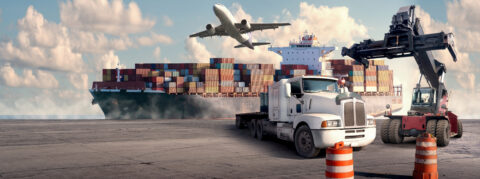Sunday Times Supply Chain
Better Trucking Through Technology
Long-distance freight transport has been a key aspect of the supply chain for decades, but it’s witnessed many technological changes and has truly come into its own over the past 20 years. In the modern world of the Fourth Industrial Revolution, connectivity is king, with computers, machines, sensors, systems and a myriad of devices all connecting to the internet, data hubs and cloud platforms – what is today referred to as the Internet of Things (IoT).
With the ability to gather vast volumes of information in this way, the use of artificial intelligence (AI) enhances the ability to process this data and enables organisations to apply it in productive, human-centric ways that provide a vast amount of additional safety and visibility with respect to long-distance driving.
Research conducted by Arrive Alive suggests that driver tiredness causes more than 20 per cent of long-distance accidents. Therefore, the implementation of smart devices such as camera systems, sensors and advanced driving solutions can significantly aid in driving down the number of accidents, ensuring the wellness of drivers and safety of all road users, and, of course, the integrity of the supply chain.
Leveraging technology
Maretha Gerber, head of Mercedes-Benz Trucks South Africa at Daimler, points out that technology is a key factor today in improving both road safety and the security of the supply chain. “On one hand, there is the aspect of ensuring the vehicle is in optimum condition, through the implementation of preventative maintenance. On the other, driver safety is vital as well.
“At Mercedes-Benz Trucks, we focus on driver safety and behaviour through the addition of advanced technology into our trucks, including vehicle monitoring systems like Fleetboard, which is now a serial standard on all Actros and selected Arocs models.”
Gerber explains that Fleetboard has numerous facilities, including the ability to maintain trip records, enable driver and vehicle performance analysis, and ensure service records, as well as providing mapping, reporting and rapid tracking services. “In addition to this solution, we also look at product innovations that will enhance vehicle performance and driver comfort. These include elements such as the Mirrorcam, which has replaced conventional mirrors and provides more visibility and efficiency, along with the Predictive Powertrain Control. The latter is a function fitted to the vehicle that proactively selects the correct gear and optimises the performance of the truck based on the topography of the road, thus providing a smoother drive and improved fuel consumption overall.”
Assisting drivers
Clay Colegate, business development executive at DriveRisk, adds that an advanced driver assistance system (ADAS) lies at the forefront of ensuring the overall safety and alertness of drivers. “Long-distance driving poses many cognitive challenges to a driver, specifically fatigue, lack of alertness and inattention. With ADAS technologies as a co-driver providing insights and pre-warnings, drivers can not only make better and more informed decisions, but also react to and avoid potential accidents and incidents.”
Technologies that form part of the ADAS sphere are predominantly camera and sensor based, explains Colegate. “Externally, they monitor the oncoming environment and alert a driver to potential risks, providing enough time for reaction to an impending collision with a vehicle, pedestrian or object in the road.
“Internally, monitoring the wilful and habitual behaviours of a driver not only highlights the areas of concern in their driving behaviour, but also alerts the driver to behaviours that may need instant rectification whilst driving, such as fatigue, distracted driving and inattention. Rather than taking a reactive approach, these technologies proactively monitor behavioural risk at the source.”
Improving security
Security within a fleet is another critical aspect, continues Colegate. This encompasses the security of the asset, of the cargo, of the employee and, most importantly, of the data.
These factors can be monitored in tandem.
“The link to storage and the actual storage of the data on servers need to be closely monitored for security breaches or suspicious activity,” says Colegate. “At a minimum, in-vehicle technology suppliers should have a sound security policy, based on ISO 27001 specifications. Furthermore, they should ensure that their back-end infrastructure, data centres and production databases are encrypted and monitored 24/7.”
Francois Stols, CTO at Altron Netstar, suggests that since the majority of these long-distance trucks carry high-value cargoes, physical safety and security are also critical. He explains that many of these vehicles are, for example, able to detect signal jamming, particularly GSM jamming, which could indicate hijackers in a specific area.
“In 2021, a key focus area will be cargo security,” says Stols. “Cargo security and asset tracking are becoming more important, with companies utilising AI and IoT in this regard. Usually there is a tracking unit on both the trailer and the horse, so if there is an unexpected separation of the two, for example, it will immediately sound an alarm.”
Stols points out that with route monitoring functionality, it is easy to set parameters relating to where a driver is or is not allowed to stop. This application also enables the control centre to determine the average time it should take to get from one point to the next. That way, if the vehicle is delayed for any reason, an alarm can also be sounded.
“Finally, there is an increasing move to bring in data from third-party providers that will enhance the security model further,” adds Stols. “This could be as simple as obtaining data from the weather services to warn drivers ahead of time of adverse conditions. At the same time, it can be used to alert them to instances of things like civil unrest, ensuring they can safely avoid that particular area.”
A bright future
“Five years ago,” continues Stols, “Netstar, a subsidiary of Altron, was storing in the region of 20 million data points a day, but today that has increased to more than 300 million per day and is growing exponentially. With all this data available, along with the ability to better leverage AI and more advanced analytics capabilities, it has become possible to build truly effective predictive models, something that will play a huge role in the industry moving forward.”
Daimler’s Gerber adds that something that is also beginning to have an impact elsewhere in the world, and will likely reach SA once the right levels of connectivity are achieved, is the use of autonomous vehicles. “This should significantly reduce wear-and-tear, accidents and many other issues that are part and parcel of having human drivers. From a Daimler point of view, apart from optimising the current technologies we use, we are also actively working together with our HQ on the electrification of our trucks, which we see as the future of trucking.”
The safety of long-distance driving will no doubt continue to be at the forefront of technological development, and the increasing implementation of modern technologies like AI will only help logistics organisations in managing both the risks of, and the growing need to, move goods and people safely.
Gerber says the shift in focus from mechanical to technological advancements has required all original equipment manufacturers to provide more tech-savvy trucks and operations to improve safety and support customers. “The growing focus on digitalisation, uptime and driver assistance has further improved the industry. In the end, the ongoing implementation of the latest technologies has contributed significantly to a shift in an industry that requires increased road efficiency – delivering greater safety, maximised use and lower total cost.”






 Sign-up and receive the Business Media MAGS newsletter OR SA Mining newsletter straight to your inbox.
Sign-up and receive the Business Media MAGS newsletter OR SA Mining newsletter straight to your inbox.